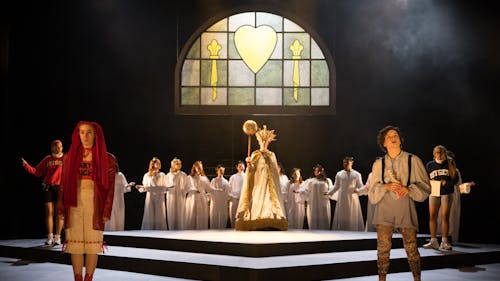Rutgers Theater Company's 'The Giant Void In My Soul' resonates with lost souls

On Thursday, the Mason Gross School of the Arts acting troupe, Rutgers Theater Company, held the first of six performances of Bernardo Cubría's "The Giant Void in My Soul."
The play, which ran from February 29 to March 3, follows two humanoid best friends, Fool 1 and Fool 2, as they stumble through life with many questions and very few answers.
Before the official showtime, the curtains were drawn up, exposing the audience to the cast leaping across the stage in outfits akin to those of circus performers. The stage was decorated to look like a circus tent to emphasize the madhouse, loony visuals.
Despite this playful facade, the show had something the audience should pay closer attention to.
The source material, which is inspired by "Don Quixote" and "Waiting for Godot," is beautifully translated to the stage of the Victoria J. Mastrobuono Theater in downtown New Brunswick.
Act I opened with the introduction of Fool 1 and Fool 2, self-proclaimed best friends with animated personalities. They tie each other's shoes, and they know what the other is thinking. Their lives are perfect — until a red fabric drops from above.
Behind the cloth, they see Fool 1's psyche. Soon, the fools spot a troubling feature: a giant void. According to Fool 1, they tried their best to bury that void, but it hasn't left. Fool 2, the ever-selfless and loyal best friend, vows to help free Fool 1 of their burden, but his void still continues to grow.
While their adventures are humorous, what resonates is a pervasive sense of unfulfillment, a challenge that many are plagued with on a daily basis.
It was apparent by the second act that fools were everywhere. Everyone was a fool, no matter if they were audience members or characters in the play.
A unique feature of the play included the constant swapping of the lead actors, driving home the point that everyone is walking around with a gaping void.
Fool 1's revolving circle of actors included Hazel Armenante, Maddy Fox, Amy Harris, Julia Jadwiga and Madison Moore, all Mason Gross sophomores.
Fool 2's rotating ensemble included Ananda Barnes, Ashavari Bhattacharya, Ellie DeMan, Lilith Freund and Zoë Reed, also all Mason Gross sophomores.
All this chaos is held together by the steady presence and vision of director Rebecca Miller Kratzer, who also serves as a co-adjunct at Rutgers.
One of the greatest aspects of "The Giant Void in My Soul" is its self-awareness, a result of the brilliant script that translates the head-cracking complexities into a far more digestible comedy.
Viewers were suddenly yanked back into the play at the start of Act II, when the Fools charged through the audience aisles and hopped back on stage.
On the closed curtain, a projected message read, "If you see them, they can see you."
If that wasn't ominous enough, the characters began directly addressing the audience. Following quick quips about the audience's clothing, the Fools honed in on select audience members to call out their obvious "voids."
Then, there is a bit of a time jump in Act II — Fool 1, now successful and married with kids, is utterly miserable. The void is persistent as ever, and it doesn't help that the once best friends were estranged.
It's a tale as old as time. Fool 1 made the grave error of neglecting the festering void within their soul. Instead of continually seeking answers, they chose to abandon their quest altogether.
"The Giant Void in My Soul" was ultimately a poignant, cautionary tale. Everyone is a fool, and trying to fill your void with superficial accomplishments will not make things better.



